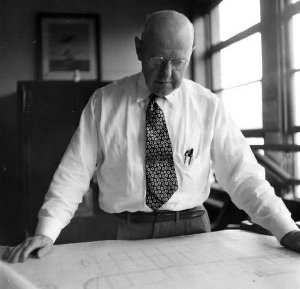H.C. Hanson
Born Oct. 9, 1892 in Tacoma, Washington, Harold Cornelius Hanson learned shipbuilding during his teenage years from his father, who was superintendent of shipyards for Pacific American Fisheries on Eliza Island, Washington. While working with his father, he learned design, operation and repair of tenders, barges, fishing vessels and other working boats. Hanson obtained a high school diploma by correspondence courses and later attended Western Washington College of Education in Bellingham and the University of Washington in Seattle. Despite this educational background, his career was built almost entirely upon practical experience. During his career, Hanson produced from 2,500 to 3,000 designs, from which more than 18,000 boats and ships have been built.
A Long Career
At age 16, Hanson was already designing and building wooden dories in a single day. In 1915, Hanson, 23, was hired as chief draftsman and assistant superintendent at Heath Shipyards in Portland, Oregon, where he designed a fleet of schooners for the Australian government. A year later he became superintendent and chief designer for Sloan Shipyards in Olympia, Washington.
By 1918, Hanson assumed the position of chief inspector at the Puget Sound shipyards for the U.S. government's Emergency Fleet Corporation. In addition to his inspection duties, Hanson taught shipbuilding classes at a Tacoma high school to train shipworkers for World War I. After the war, Hanson went to work for the government as a representative to the budding Pacific Northwest shipbuilding industry.
In 1922, Hanson left the Emergency Fleet Corporation and went into business for himself as a naval architect and marine engineer, establishing a reputation for innovative, trendsetting designs. Among his credits are the Vulcan, the first all-steel cannery tender, and the Ruby II, the first Puget Sound-built all-steel tug. Hanson's revolutionary welded-steel designs also largely contributed to the opening of the Columbia River in Washington State.
During World War II, Hanson acted as a representative to the U.S. government for shipyard interests in Washington, Oregon and northern California, earning numerous contracts and commissions for Pacific Northwest shipyards. Among the vessels built under Hanson's supervision and consultation were minesweepers, Navy patrol boats and Army tugs.
After the war, Hanson continued his design career until he retired in 1972. As a recognized authority in the field of maritime engineering, Hanson spoke for the United States at many international maritime meetings, including the International Fishing Boat Congress. H. C. Hanson died on Mercer Island, Washington at the age of 82 on Sept. 22, 1975, leaving a remarkable legacy to the shipbuilding industry.
The Legacy
Hanson's naval architecture career, spanning from 1907 to 1972, was an integral part of the Pacific Northwest's most intense period of maritime activity. Though known principally for his wooden commercial fishing boat designs, Hanson was also vitally involved during both World Wars in military vessel design and construction. Hanson-designed vessels were not only seaworthy but visually graceful; as a result many are still esteemed and in active service around the globe. The H. C. Hanson Naval Architecture Collection is a unique collection of plans, photographs, periodicals and other assorted materials detailing the life and work of this revered designer of commercial watercraft.
The collection includes more than 11,000 blueprints, 4,200 original line drawings of boats and boat details, 4,800 photographs and negatives documenting the shipbuilding industry from 1918 to 1970, nearly 10,000 periodicals and books, 17 half-hull models, numerous ship fixtures, drawing tools and Hanson memorabilia. The H. C. Hanson Naval Architecture Collection was donated unconditionally to the Whatcom Museum by the Hanson family and was accepted by the Museum into its permanent collection in 1982. Owners of Hanson-designed vessels, practicing naval architects, model boatbuilders, and marine artists alike will find it informative and inspiring.
